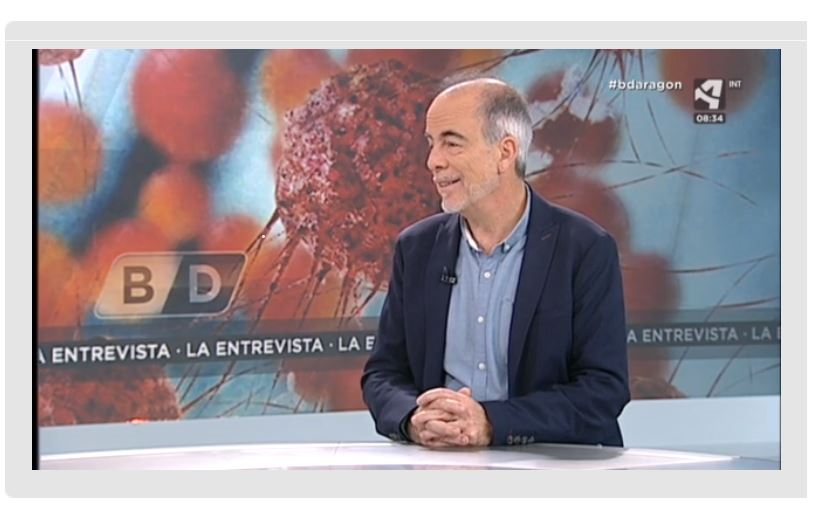
Jesús Santamaría, who leads the NFP research group of CIBER-BBN and the Institute of Nanoscience of Aragon (INA), at the University of Zaragoza, in an interview on October 29 to Aragon TV, talks about the problems in the fight against cancer and explains in a very didactic way, the solutions that are being approached from his research group, in collaboration with other groups. It would consists, basically, in reducing the tumor from inside the tumor cells. Prof. Santamaria has been granted funding twice from the European Research Council (ERC) Advanced Grant program for catalysis-related projects, the last one with two and half million euros to continue their investigation on the use of catalysis in oncology. The synthesis of nanoparticles and the characterization of these experiments is carried out in NANBIOSIS U9 Synthesis of Nanoparticles Unit directed by Jesús Santamaría and Gema Martínez.
The Professor of chemical engineering at the University of Zaragoza, Jesús Santamaría, explains that “killing cancer cells is not too difficult, compared to other cells, but what is difficult is to hit the target of delivering the drug precisely to these cells and not to healty cells. Because of this, the treatment is often limited by the amount of chemo that the body can tolerate since therapies have very strong side effects”
“Through nanotechnology – Dr. Santamaría continues – we make several approaches: one is the introduction of treatments in intelligent nanoparticles aimed at the tumor, they are injected into the blood and are expected to reach the tumor; and the other is the one proposed by Jesús Santamaría’s team, to fight the tumor from inside the tumor cells by introducing a catalyst that causes certain reactions to occur and in this case, to generate a toxic substance. Thus, if it is done well, the chemotherapeutic would be located inside the tumor and more amount of drug could be applied more efficiently and with much less side effects to the patient as it is not distributed throughout the body; It would mean a chemo factory inside the tumor thanks to the catalyst, -says Santamaría – This has several problems: the first is th arrival of the catalyst to the tumor and not to another site, but, what you we are transporting through the body is not a drug but a catalyst that is biodegradable”
Once the catalyst is in the tumor, it can behave in two different ways depending on the type of catalyst, one removes nutrients from the tumor, for example glucose, killing the tumor from starvation, and the other kills the tumor by toxicity, as Prof. Santamaría explains: “a prodrug is introduced, which is a toxic drug with a group that inactivates it till the catalyst removes the inactivator, so that an inert molecule is transformed into a toxic one inside the tumor, in this way, the toxicity factory is inside the tumor and it will be possible to continue generating toxicity while we give it the prodrug”.
For the catalyst to reach cancer cells, researchers follow two types of approaches. Nanotechnology sometimes uses functionalized nanoparticles with antibodies that recognize parts of specific molecules that are expressed in tumors, this technique has its limitations and it is not working so well as expected. The other way is the strategy of Trojan horses. What things can we use as Trojan horses? –asks Santamaría- . Two approaches have been tested: one is the dendritic or mesenchymal stem cells which have tropism towards the tumors . These cells are first loaded with therapeutic nanoparticles, then injected into the bloodstream, and use their selective tropism takes to reach the tumor. The other possibility of Trojan horse that researchers have shown in cell cultures is to use, not cells, but something that cells emit called exosomes that are vesicles sent out by cells to communicate with each other, that have a piece of membrane capable to recognize the cell where they come from. Researchers have found a way to collect exosomes from tumor cells and introduce into them, without touching the membrane, a catalyst verifying that exosomes recognize the cells where they come from, look for them and join them.
You can follow the interview by Jesús Santamaría to Aragón Televisión in Spanish in this link http://alacarta.aragontelevision.es/informativos/buenos-dias-aragon-29102019-0800 aprox. min 33-44.
For further information:
https://www.ciber-bbn.es/noticias/introducen-catalizadores-como-caballos-de-troya-en-celulas-tumorales-para-matarlas-desde-su-interior
Article of reference: Cancer-derived exosomes loaded with ultrathin palladium nanosheets for targeted bioorthogonal catalysis María Sancho-Albero, Belén Rubio-Ruiz, Ana M. Pérez-López, Víctor Sebastián, Pilar Martín-Duque, Manuel Arruebo, Jesús Santamaría and Asier Unciti-Broceta. Nature Catalysis 2019 DOI https://doi.org/10.1038/s41929-019-0333-4








